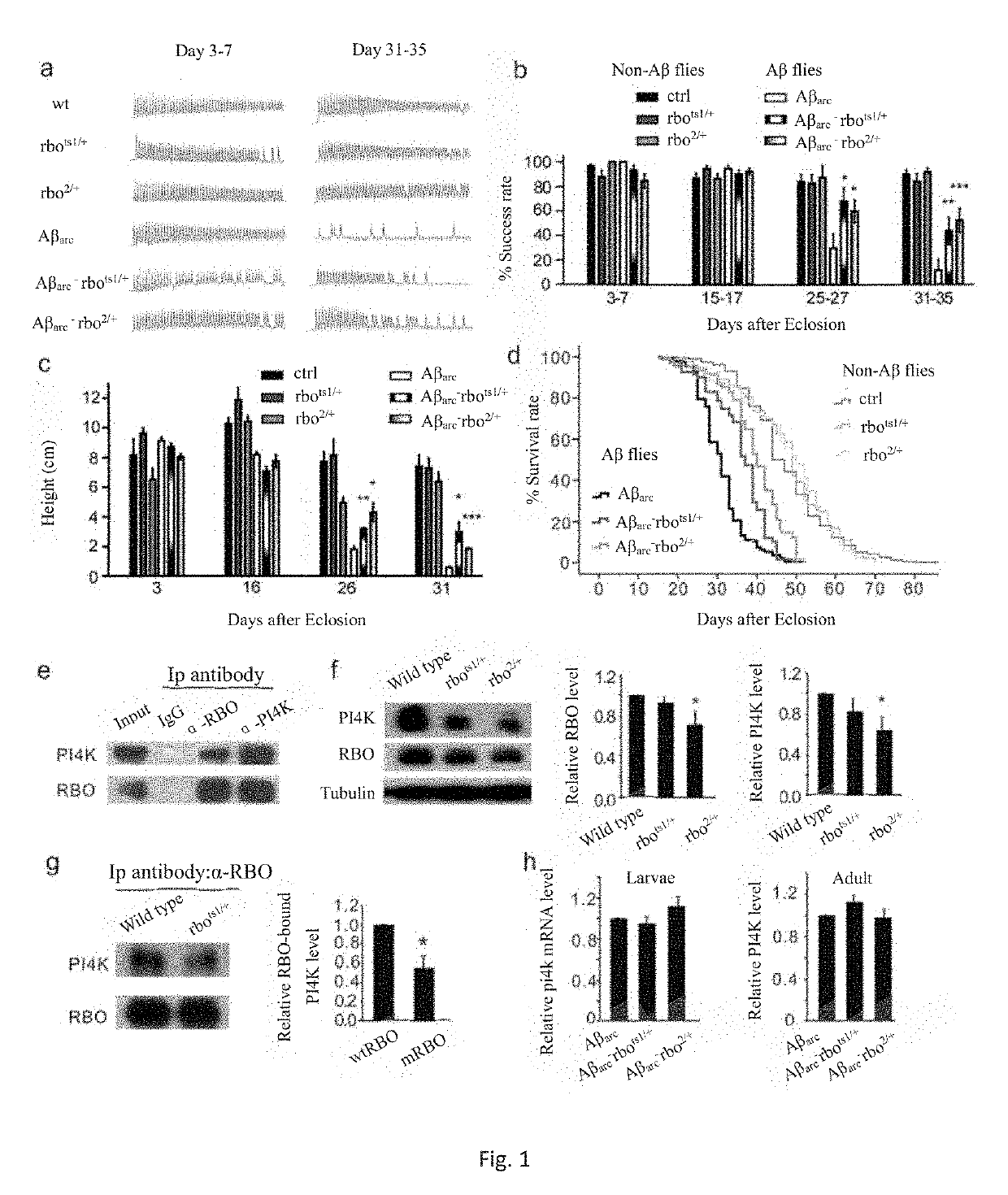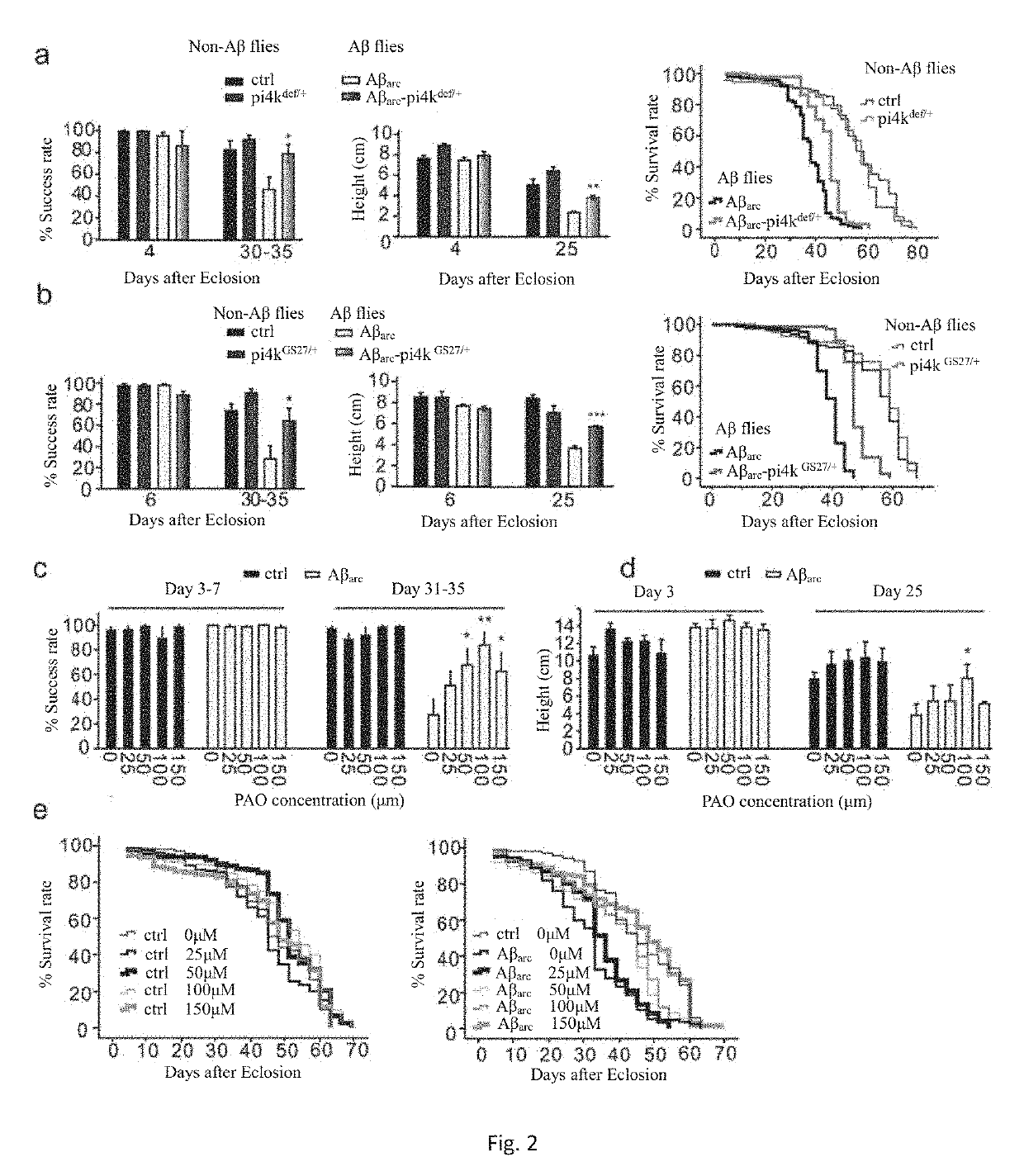Application Of PI4KIIIA Protein And Related Membrane Protein Complex In Treating Alzheimer's Disease
a technology of membrane protein and alzheimer's disease, applied in the field of medicine, can solve the problems of not finding a compound or molecule that may improve learning and memory, prevent the further deterioration of learning and memory dysfunction, and improve learning and memory. , to achieve the effect of reducing the pi4p level
- Summary
- Abstract
- Description
- Claims
- Application Information
AI Technical Summary
Benefits of technology
Problems solved by technology
Method used
Image
Examples
example 8
Preparation and Toxicity Examination of PI4KIIIα Inhibitors PAO, A1 and G1
[0127]HEK293 cells, Drosophila larva, and adult flies were treated with PAO or A1, stock solutions of 10 mM and 0.9 mM A1 was made separately by dissolving PAO powder (Sigma-Aldrich, CAS NO. 637-03-6) and A1 powder in DMSO. Then gradiently diluted with distilled water to the desired concentrations; the final concentration of DMSO was adjusted to identical level to ensure the experimental results were not influenced by DMSO variation.
[0128]To test the toxicity of PAO on living flies, we cultured wild type flies with fly food containing 50, 100, 200, 300, 400, and 600 μM PAO, started from embryonic stage. It is found that PAO treatment at 200 μM or less neither changed the eclosion rate nor altered the climbing ability after eclosion. Thus 25, 50, 100, and 150 μM PAO were chosen for culturing Aβarc and control flies.
[0129]To test the toxicity of PAO on dissected Drosophila third instar larvae, Schneider's cultur...
example 11
ration and Microinjection in Mice
[0144]Lentivirus was produced by invitrogen (Shanghai) using the BLOCK-iT™ HiPerform™ Lentiviral Pol II miR RNAi Expression System with EmGFP. Four miRNAs oligos targeting Efr3a were synthesized and inserted into pcDNA™6.2-GW / EmGFPmi vector. Knockdown efficiency was tested by RT-PCR or Western Blot method. Results showed that one of the vectors was most effective in knocking down Efr3a expression in HEK293T cells over-expressing EFR3a gene. Sequence of vector having the highest knockdown efficiency is AGGTATCATTCAGGTTCTGTT. The most effective miRNA vector was recombinated with pDONRTM221 and pLenti6 / V5 DEST to generate the pLENT6 / V5-GW / ±EmGFP-miRNA vector via Gateway® recombination reactions. Lentivirus was generated by co-transfection of the pLENT6 / V5-GW / ±EmGFP-miRNA vector and Packaging Mix. Viral titer was obtained by serial dilutions in HEK293T cells. EGFP-positive cells were counted every 3 days. Knockdown efficiency was further obtained in lent...
example 12
kdown May Repair Atrophy of Neuronal Dendrites in APP / PS1 Mice, Tested by GFP Staining in Mouse Brain Slices
[0146]GFP staining in mouse brain slices: Brain slices (60 μm thickness) were blocked with PBS-0.3% triton-5% BSA for 1 hr., followed by incubation with rabbit anti-GFP antibody (A11122, invitrogen, 1:100 dilution) overnight at 4° C. Then wash with PBS, incubate with biotinylated goat anti-rabbit IgG antibody (H+L) (AbboMax, Inc, 1:100 dilution) overnight at 4° C. PBS wash again, incubate with Cy3-Streptavidin (Jackson ImmunoResearch Laboratories Inc, 1:1000 dilution) for 2 hrs at RT. Images were taken under Zeiss LSM 511 confocal microscope, deconvoluted with AutoQuant X2, and analyzed with NeuronStudio software. The genotypes of brain slices and images of dendrites were blind to the imaging and analyzing personnel, respectively.
[0147]In FIG. 11, RT-PCR was adopted to analyze the knockdown efficiency of internal EFR3a (a) and PI4KA gene (b) in HEK293 cells, over-expressing mo...
PUM
| Property | Measurement | Unit |
|---|---|---|
| temperature | aaaaa | aaaaa |
| frequency | aaaaa | aaaaa |
| width | aaaaa | aaaaa |
Abstract
Description
Claims
Application Information
 Login to View More
Login to View More - R&D
- Intellectual Property
- Life Sciences
- Materials
- Tech Scout
- Unparalleled Data Quality
- Higher Quality Content
- 60% Fewer Hallucinations
Browse by: Latest US Patents, China's latest patents, Technical Efficacy Thesaurus, Application Domain, Technology Topic, Popular Technical Reports.
© 2025 PatSnap. All rights reserved.Legal|Privacy policy|Modern Slavery Act Transparency Statement|Sitemap|About US| Contact US: help@patsnap.com



